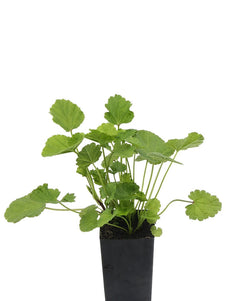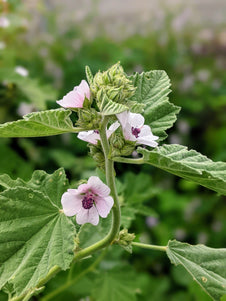





Marshmallow
Marshmallow

- In stock, ready to ship
- Inventory on the way

Usually available: All year
Life cycle: Herbaceous Perennial
Height: 90cm - 1.2m
Position: Full sun
Soil preference: Moist / well drained
This is how we pack and send your Herb Plants to all states except TAS & WA
You will receive
- 1 Marshmallow Herb Plant in a 50 X 75mm tube - General growing instructions
All of our Herb Plants are grown organically with certified organic potting mixes and fertilizers
Botanical Name: Althaea officinalis
The Marshmallow plant is a tall perennial which resembles a Hollyhock in appearance. It may grow 90-120cm, depending on the local climate conditions. The large leaves are round or ovate-cordate and approximately 4-8 cm long by 3-4 cm wide. The soft, thick green leaves have 3-5 lobes, serrated edges and a velvety down covering the surface. The leaves grow smaller as they wind up the plant on smaller lateral stems, which also lead to the flowers.
The flowers travel up the stem to the top of thick stalks, where many may be open at once. They are usually of a pale lilac to white colour unlike the Common Mallow (Malva sylvestris) which has a glamorous purple flower. The 5 flower petals are given texture from the striations on the petal surface, contrasted by the purple anthers and stamens in the centre. Flowering is in summer, pollination is usually by bees and the plant will later self seed readily. The seed pods are quite large and resemble cheese wheels, leading to the colloquial name of ‘cheeses’.
One of the most significant parts of the plant is the long, thick and tough tap root which is also mucilaginous. This is where much of the plants traditional medicine value is derived, although it is also edible. Marshmallow was once an old garden favourite, kept for its medicinal qualities as much as the striking flowers. The usual habitat for Althea officinalis is near river banks, in damp meadows, ditches and salt marshes. It is native to Europe and Western Asia, along with other species in the Althea genus.
The Malvaceae or mallow family of plants is large, having over 1000 species, with most found in tropical regions of the world. The name is from the Greek ‘malate’ meaning soft and was given due to the softening and healing qualities of the plants. Many are common garden plants and include the hibiscus and hollyhock. The Common Mallow is also called Marshmallow where it grows naturally. However, the true Marshmallow has more mucilage and may be distinguished by the many divisions in the outer calyx, a feature not present in the other species. The genus name for Marsh Mallow is Althea, from the Greek word ‘altho’, meaning ‘to cure’ due to the plant’s healing properties. Other names include Cheeses, Mallards, Schloss Tea, and Mortification Root.
There are stories that the confectionary marshmallow received its name due to the resemblance to the large flowers of this plant. However, it is instead because the original ‘marshmallow’ was made from the plant itself. Early medicinal use of this plant by Ancient Egyptians, Romans and the more recent French past, resulted in the creation of a ‘medicinal confection’. Originally this concoction was an emollient paste made from the root of Althea officinalis and was intended for treating sore throats, cough and hoarseness. Later, French confectioners mixed in meringue and rose water. Eventually this evolved into the sugar based confection that is the marshmallow today – except without the health benefits bestowed by the mallow plant.
Growing Conditions
Althea officinalis prefers moist, sandy soil with natural habitats usually having water nearby (like marshes) or very damp conditions. However, it is not necessary to grow Marshmallow in boggy ground or marshes, as the name suggests. All soil types are suitable, but there should be a constant water supply with drainage, rather than a waterlogged soil. Sandy, well drained soils are prone to drying out and need to have regular water to maintain good plant condition. Occasional dry spells will be tolerated, but the mallows will not tolerate drought or ongoing dry, hot conditions. Full sun is a requirement since shade is not tolerated well. However, the harshness of the sun may be a consideration when determining where to position the plant.
In cool conditions, the Marshmallow plant will die down in autumn or winter and return in spring by sending up many unbranched stems. The Marshmallow plant may be raised from seed, sown in spring or left to self-seed. Cuttings will also do well, but most people simply propagate by dividing the roots in autumn and re-plant about 60 cm apart. The leaves, roots and flowers may be used medicinally and for culinary purposes. It is best to pick the plants or leaves after the sun has dried any morning dew. To pick whole plants or just the leaves, do so just before the flowers bloom in summer.
Medicinal Uses
One of the main medicinal uses for Marshmallow is for pain and swelling of mucous membranes that line the respiratory tract, sore throat and for a dry cough that lingers after the main infection has passed. It works by helping to form a barrier or protective layer on the membranes and contains chemicals that may decrease coughs and also heal any wounds. The Marshmallow is also considered useful for inflammation of stomach lining, heartburn, diarrhoea, ulcers, UTI, kidney stones and other urinary tract concerns, for external inflammation, bruises, aches, sprains, swelling of feet and hands, chapped skin, and for treating insect bites. Consuming the Marshmallow plant may also affect blood sugar levels, particularly before and after surgery.
The medicinal benefits are derived from the mucilage present throughout the plant. This enables the preparations to act as a demulcent and sooth mucous membranes in the body. The root contains 37% starch, 11% mucilage and 11% pectin and chemicals such as phenolic acids, flavonoids, sucrose and asparagine. Traditional medicine sees the Marshmallow as having a cooling and moistening effect on the body, bringing relief from conditions causing the body to be ‘hot and dry’. The historical use of this plant as a poultice for external sores and wound lead to the name Mortification Root, because it was able to prevent gangrene.
Marshmallow may be used as a cold or hot infusion, more commonly it is prepared cold. This helps to extract a more pure concentration of the mucilaginous polysaccharides, whereas the warm infusion made by simmering the root also extracts the starches. To prepare a cold infusion, fill a small jar or cup with ¼ Marshmallow root and the rest with lukewarm water. Cover and let it stand for 4 hours or overnight and watch the liquid turn yellow and then thicken with the mucilage. The roots may be strained away and then the liquid used for various purposes. It is used as an external skin wash, throat gargle and to treat many of the ailments listed above.
Boiling the roots (half roots to water ratio) instead will result in a more gum-like, starchy substance. This is said to be good for soothing intestinal irritations, urinary tract complaints and treating external aches, bruises and sprains. When boiled in wine or milk the mallow root is useful for treating coughs and bronchitis, in conjunction with other treatments. Powdered roots are useful for external poultices, flowers boiled in oil are a good sore throat gargle and an ounce of leaves boiled in water makes an infusion good for bathing inflamed eyes.
Culinary Uses
Most of the mallow family of plants have been used as vegetables since early times. The flowers and young leaves may be added to salads, boiled or fried. The roots have a parsnip like taste and can be boiled or experimented with in other ways. The early Romans considered a vegetable dish of Marsh Mallow to be a local delicacy. Ancient Egyptians were said to mix the roots with nuts and honey and for them mallow was also considered to be a famine food. Today the mallow plant is still used as a last resort in many areas experiencing famine around the world. In France, the young tender leaves are used in raw salads and the roots are made into syrup, due to their value as a kidney tonic. Specialist confectioners sometimes still make the original ‘marshmallow’. Modern marshmallow does not have any content from mallow plants.
Other Uses
The root of Marshmallow has emulsifying properties which are used for leaning Persian carpets in the Middle East. It is regarded as one of the best methods available for maintaining the stunning colours in the carpets. The roots and stem secrete mucilage and this is often used in cosmetic treatments to soften the skin. The leaves can be dried and used to brew a marshmellow leaf tea.
All information provided on this website is for informational purposes only. Please seek professional advice before commencing any treatment.






